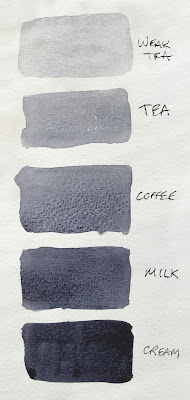I painted out a lovely triad with DS yellow ochre, DS cerulean chromium and Sharlie's Pinkcolor deep - a gorgeous colour somewhere between Potter's Pink and Indian red - either of which could equally be used in an earthy primary wheel like this. I posted it on Instagram (Janeblundellart) but I wanted to give a little more information here.
I was sent some samples of some hand-made watercolours to try out. Sharlie also loves granulation and has been making a small quantity of each colour to test. As I have tested so many pigments over the years, there were not many that were completely 'new' or original for me, but her Lapis Lazuli is more beautiful than the commercial ones I have tried and I really like the Pinkcolour deep - much more interesting then the usual very soft watercolour known as Potter's Pink. I guess I just prefer stronger colours - you can always dilute them. I also really liked the Moroccan earth colours and the lovely rich Maya Blue.
Here are the colours I tested out.
Making my own watercolours, like making my own sketchbooks, is something I have chosen not to do. I want to spend time sketching in the books or painting with the watercolours! However I really admire those who go through the effort of making their own. Sharlie's rewet and painted out very nicely, unlike some others I have tested.
She has an Etsy shop called biscuitswatercolor, where she sells half pans of handmade watercolour. I don't have an Etsy account so can't post a link. I believe she has a number of other colours besides these :-)
2018
Here are some more lovely handmade watercolours. It's the first time I've seen PB71 and such a gorgeous strong Potters Pink. The Graphite sparkles!
 |
| Handmade watercolours by Sharlie. Pigments shown if known. |
 |
| Handmade watercolours by Sharlie. Pigments shown if known. I love the Potter's Pink and Red Ochre. |
 |
| Handmade watercolours by Sharlie. Pigments shown if known. This is the highest chroma yellow ochre I have tried. I assume it is PY43 but don't know for sure. |
 |
| Handmade watercolours by Sharlie. Pigments shown if known. The PV15 is a gorgeous blue-purple. Lovely to see PB71 - rather like a Cerulean but not the same. |













